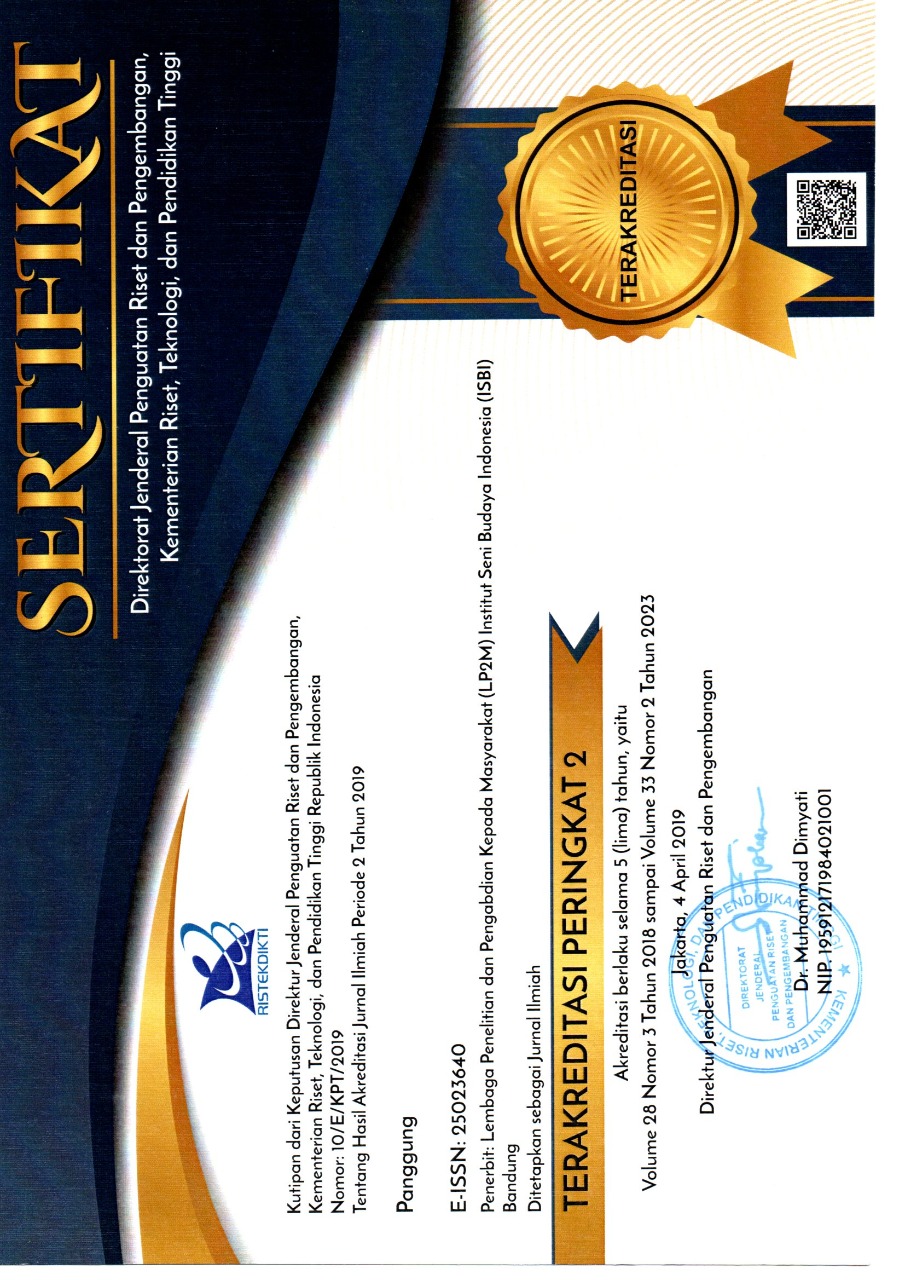Potensi dan Permasalahan dalam Pengembangan Seni Kerajinan Tiohu (Mendong) Gorontalo
Abstract
Full Text:
PDF DOWNLOAD (Bahasa Indonesia)References
Athia, I., & Primanto, A. B. (2020). Kriya Mendong: Upaya Diversifikasi Produk Potensi Desa, Kreasi Wirausaha Masyarakat Desa Blayu dengan bantuan Aplikasi Teknologi Multimedia. JAST : Jurnal Aplikasi Sains Dan Teknologi, 4(2), 106115.
Charmaz, K. (2012). The Power and Potential of Grounded Theory. A Journal of the BSA MedSoc Group, 6(3), 215.
Frese, M., Gielnik, M. M., & Mensmann, M. (2016). Psychological Training for Entrepreneurs to Take Action: Contributing to Poverty Reduction in Developing Countries. Current Directions in Psychological Science, 25(3), 196 202.
Guntur. (2019). Inovasi Pada Morfologi Motif Parang Batik Tradisional Jawa. Panggung: Jurnal Seni Budaya, 29(4), 373390.
Hasan, F. A., Munawar, S., & Dangkua, S. (2022). Kerajinan Anyaman Amongo Tiohu Di Kabupaten Bone Bolango (Kelangsungan dan Perkembangan). Jambura: Jurnal Seni Dan Desain, 2(1), 17.
Jufri, A., Yasin, M., Sahri, & Wahyunadi. (2021). Pengelolaan Usaha Industri Kerajinan Tikar Mendong Melalui Diversifikasi Produk Di Desa Lenek Kecamatan Lenek Kabupaten Lombok Timur. Sangkabira, 1(2), 7890.
Khardiansyah, M. W., Sudarmawan, A., & Sila, I. N. (2021). Kerajinan Tikar Mendong Di Desa Paok Pondong Kecamatan Lenek Lombok Timur Nusa Tenggara Barat. Jurnal Pendidikan Seni Rupa Undiksha, 11(1), 1219.
Kielmann, K., Cataldo, F., & Seeley, J. (2012). Introduction to qualitative research methodology: A training manual. UK: Department for International Development (DfID).
Marbun, J., Sudarmadji, & Suprayogi, S. (2016). Penurunan Budidaya Tanaman Mendong (Heleocharis Chaetaris Boeck.L) Sebagai Bahan baku Kerajinan Tangan Di Padukuhan Parakan Kulon dan Plembon Desa Sendangsari, Kecamatan Minggir, Kabupaten Sleman, Yogyakarta. Majalah Geografi Indonesia, 30(1), 5867.
Otaya, L. G., Tjabolo, S. A., & Husain, R. T. (2019). Analisis kebutuhan pemberdayaan ibu rumah tangga miskin melalui usaha kerajinan tangan khas Gorontalo Mohalamu Tiohu. JPPM (Jurnal Pendidikan Dan Pemberdayaan Masyarakat), 6(1), 5975.
Patria, A. S., & Mutmaniah, S. (2015). Kerajinan Anyam Sebagai Pelestarian Kearifan Lokal. Dimensi, 12(1), 110.
Sudana, I. W. (2014). Strategi Pengembangan Kerajinan Keramik Gerabah Tradisional Gorontalo Guna Mendukung Industri Kreatif. Mudra: Jurnal Seni Budaya, 29(2), 163180.
Sudana, I. W., & Mohamad, I. (2021). Konsep Pengembangan Seni Kerajinan Eceng Gondok Gorontalo. Panggung: Jurnal Seni Budaya, 31(2), 93109.
Sugiyono. (2012). Metode Penelitian Kombinasi (Mixed Method) (Cet. ke 3). Bandung: Alfabeta.
Suryanto, H., Marsyahyo, E., Irawan, Y. S., & Soenoko, R. (2014). Morphology, Structure, and Mechanical Properties of Natural Cellulose Fiber from Mendong Grass (Fimbristylis globulosa). Journal of Natural Fibers, 11(4), 333351.
Suryanto, H., Solichin, S., & Yanuhar, U. (2016). Natural Cellulose Fiber from Mendong Grass (Fimbristylis globulosa). In K. G. Ramawat & M. R. Ahuja (Eds.), Fiber Plants, Sustainable Development and Biodiversity (pp. 3552). Switzerland: Springer International Publishing.
Tung, F.-W. (2012). Weaving with Rush: Exploring Craft-Design Collaborations in Revitalizing a Local Craft. International Journal of Design, 6(3), 7183.
Zhang, L., & Sternberg, R. J. (2011). Revisiting the Investment Theory of Creativity. Creativity Research Journal, 23(3), 229238.
DOI: http://dx.doi.org/10.26742/panggung.v33i1.2206
Refbacks
- There are currently no refbacks.
Statistik Pengunjung Jurnal Panggung
Jurnal ini terlisensi oleh Creative Commons Attribution-ShareAlike 4.0 International License.
Editor Office:
Lembaga Penelitian dan Pengabdian Kepada Masyarakat (LP2M)
Institut Seni Budaya Indonesia (ISBI) Bandung Gedung Rektorat Lantai 4
Jl. Buah Batu No. 212 Bandung 40116
Email: penerbitan@isbi.ac.id or redaksi.panggung@gmail.com
Phone: 022 7314982 Fax: +022 7303021













